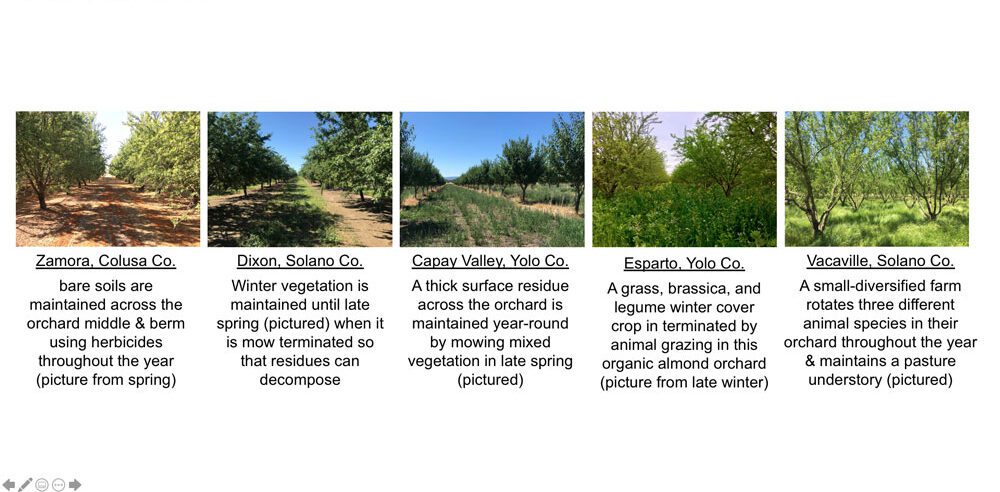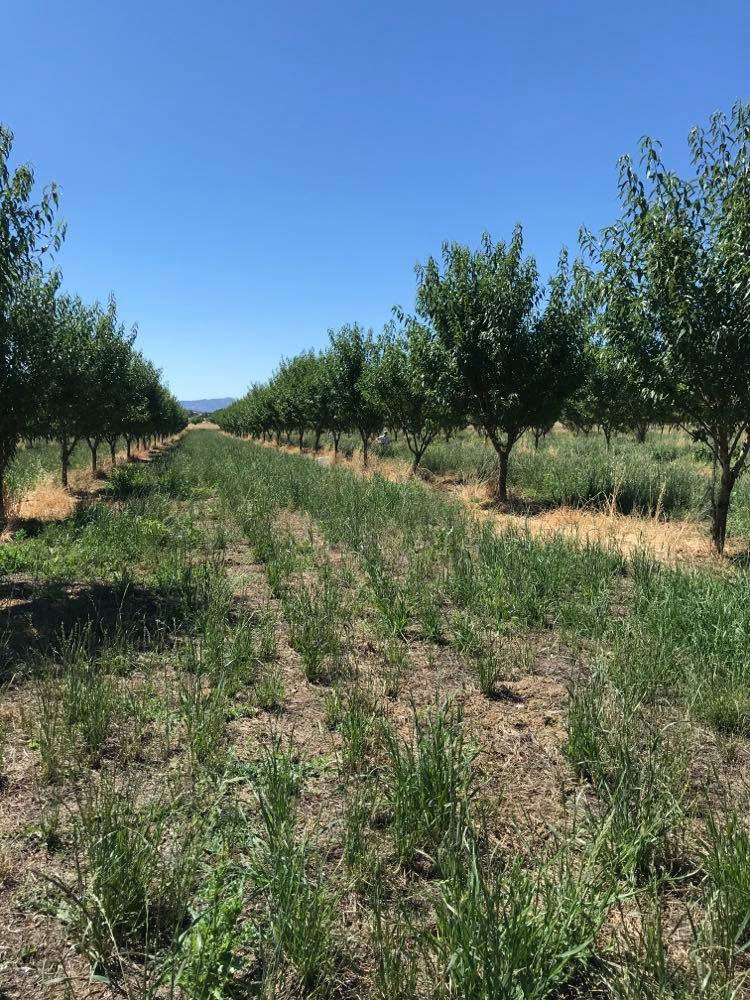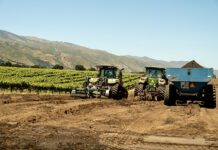
The concept of “healthy soil” has become increasingly popular over the last decade as researchers, government agencies, organizations like the Almond Board, and farmers continue learning more about the essential role soil plays in crop productivity, air and water quality, climate regulation and human health.
Benefits of Healthy Soils
Soils are complex and living ecosystems capable of supporting a wide range of functions through the activities of soil organisms (Figure 1). Among other benefits, a well-functioning soil ecosystem can:
- Promote the retention and availability of crop nutrients,
- Build soil structure to reduce topsoil loss,
- Alleviate compaction,
- Improve infiltration and soil water holding capacity and
- Build and sequester carbon.
Healthy soils have the potential to not only play a central role in individual almond orchards but also support industry-wide efforts to achieve Almond Orchard 2025 Goals. A healthy soil ecosystem in the orchard can help growers collectively advance toward specific goals such as improving water and nutrient use efficiency, recycling almond coproducts and reducing dust to improve air quality. And these numerous benefits that ultimately contribute to long-term orchard sustainability goals often do not come at the expense of productivity. In fact, a growing number of studies suggest we can build healthy soils that support multiple benefits while maintaining or, in some cases, improving crop yields.
Uncovering Healthy Soil Management Principles
Identifying the strategies for how to build healthy soils and enhance soil ecosystem functions are still being established for almond orchards. To address this knowledge gap and start developing best management practices for growers, a collaborative team of UC Davis researchers and a UCANR extension specialist are aiming to better define healthy almond orchard soil in the Sacramento Valley and identify practices already being used to improve orchard soil health.

Although the research was explicitly conducted in the Sacramento Valley region, more regional work to explore soil health best management practices is needed across California as almond producing regions vary widely in regards to soil types and climates. The research team selected 23 orchards across the Sacramento Valley region that represent a variety of management, scales of operation and farm goals (Figure 2) to capture the diverse challenges and innovative solutions used by California almond growers.
There are many management practices being promoted as ways to build healthier soils. However, the success and feasibility of these practices is highly dependent on other aspects of a grower’s operation, such as equipment availability, harvest times, weather patterns, access to resources and information, and food safety precautions. Therefore, the team recommends growers consider the foundational ecological principles that underlie soil health-building practices and, from that information, identify specific strategies that can be used to build healthy soils and enhance soil ecosystem functions in their orchards.
To determine which specific strategies show potential in the Sacramento Valley region, the team spent the last two years meeting with a wide range of almond growers whose management reflects the below principles to address orchard challenges and meet diverse goals.
Principle One: Reduced Disturbance Important
Although physical disturbances like tillage play a role in production, reducing these events minimizes the destruction of the environment where soil organisms live and perform important functions for agriculture. Given that reduced or zero-tillage management has been widely adopted across almonds, this principle is already easy for most growers to achieve in their efforts to improve soil health.
It should also be noted that minimizing disturbances, such as tillage in regions with heavy clay soil, could have tradeoffs with soil compaction, potentially inhibiting root growth and the uptake of nutrients. To address these potential tradeoffs, growers can look to build soil organic matter and reduce compaction, which leads us to our second principle.
Principle Two: Maintaining Continuous and Diverse Organic Inputs
Soil organic matter address compaction, continuous inputs of carbon and nutrients in organic forms, such as amendments, mulches, animal manure and plant residues that are essential to enhancing soil ecosystem functions and reaping the benefits of healthy soil. In fact, soil organisms like bacteria, fungi and earthworms require carbon and nutrients to live and perform essential soil ecosystem functions.
There are many creative ways to increase organic inputs in agriculture. For example, researchers documented almond growers using compost, recycled almond shells, growth of resident weeds in the winter, planted cover crops and animal manures. Although we did not work with growers who utilized whole orchard recycling (WOR), this practice recycles carbon and nutrients from aboveground biomass back into the soil ecosystem and is a useful long-term strategy for supporting healthy soil.
However, one of the most effective ways to introduce more continuous and diverse organic inputs is to maintain living plant roots, which leads to the third principle of building healthy soil.
Principle Three: Maximize Living Cover
Living root systems provide an effective way to supply resources directly into the soil. Although there are multiple management constraints to increasing living roots in almond orchards, interesting strategies that are effective and feasible for management exist. For example, resident vegetation and planted cover crops like ground clover and triticale, which have shorter stands, can be effectively managed where frost is a concern to almond growers. Additionally, planting and termination can be optimized to take advantage of winter rainfall when almond trees are dormant and competition is low. Further, appropriate selection of plants and their growth periods can help ensure that residues left on the surface are able to sufficiently decompose before harvest.
Ultimately, finding what works for any given almond orchard will take time and experimentation, a recurrent comment from growers we spoke with who are increasing the presence of living roots in their orchards.
Introducing more organic inputs, especially living covers, in almond orchards also helps promote the fourth principle of healthy soil.
Principle Four: Keep the Soil Covered
Although this principle may require adjustments to management, maintaining a surface cover is essential to building healthy soil. Covering the soil physically protects it from the environment, which can reduce soil loss by wind erosion and surface runoff. In addition, covering the soil allows for greater sunlight interception and moderation of soil temperature, both of which could help reduce water evaporation from the soil surface.
The degree to which residues are kept on the surface influences how management needs to be adjusted. For example, one grower’s cover crop was terminated early enough to allow the residue to decompose well ahead of harvest, posing no challenges. Another grower, who left a small residue layer on the soil surface, said slowing down during harvest (moving equipment through the orchard at a slower pace) allowed for sufficient nut collection. Adoption of an off-ground harvesting system would allow for the maintenance of a thick residue layer, where residues can build up over years to protect the soil surface and provide organic inputs (Figure 3).
Enhancing biodiversity in almond orchard soil is also essential, and leads to the final principle of healthy soil.
Principle Five: Support Soil Biodiversity through Diversification
There is growing consensus amongst the scientific community that soil biodiversity can promote a wide range of soil ecosystem functions. Finding ways to support soil biodiversity, such as diversifying the plants growing in the soil, can be an effective strategy to build healthy and well-functioning orchard soils.
For example, growers can plant cover crop mixes in their orchard middles that contain multiple species, such as grasses, legumes, and brassicas. Integrating animals to manage vegetation has also shown great potential as a beneficial diversification strategy for building healthy soils. However, uncertainties remain regarding best management practices, management logistics and concerns over food safety, questions that the Almond Board of California will be researching in the upcoming years.

Building healthy soils in almond orchards is essential and enables growers to not only address current management challenges but also ensure their almond productions meet long-term productivity and sustainability goals. Although gaps in our knowledge still exist around what management strategies are most effective for building healthy soils, this research allowed us to better understand what innovative and feasible strategies almond growers are already implementing to incorporate soil health into their management.
The researchers hope to continue their work to capture growers’ current soil health building strategies, better define healthy orchard soil and encourage growers to continue experimenting to learn what strategies work best for their productions.
Additional Resources
The full findings from the soil health research project will be available this upcoming year, including academic articles, outreach materials and factsheets for building soil health in almond orchards. Growers interested in learning more about living roots and the steps to incorporating cover crops, specifically in their orchards, are encouraged to read the “Cover Crop Best Management Practices” guide developed by the Almond Board of California and University of California available now on Almonds.com/covercrops. Finally, if growers are interested in learning more about WOR, they can read the “Whole Orchard Recycling Guide for California Almond Growers” and find more information at Almonds.com/WOR.
The integration of animals and use of animal manure is not currently recommended by the Almond Board of California due to food safety concerns and uncertainties regarding best management practices. To comply with food safety regulations, animals must be removed from the orchard or manures applied more than 90 days before harvest if almonds are harvested off-ground and more than 120 days before harvest if almonds are shaken onto the ground.















